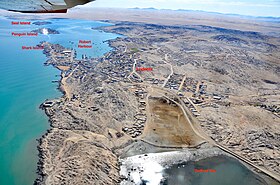Shark Island (Namibia)
| Shark Iceland Shark Island |
||
|---|---|---|
|
National monument in Namibia |
||
| Monument type | Battlefield | |
| location | Lüderitz Bay | |
| Geographic coordinates : | 26 ° 38 '11.6 " S , 15 ° 9' 7.9" E | |
|
|
||
| Emergence | ||
|
Recognized by the National Heritage Council |
15th February 2019 | |
| Deprivation | ||
| Sponsorship | ||
| Website | NHC Namibia | |
Shark Island ( German Haifischinsel ) is a peninsula on the coast of Namibia in the South Atlantic . It is located in the Lüderitz Bay .
On the island there is the Shark Island lighthouse , the Lüderitz monument (with an inscription by Adolf Lüderitz ) and a campsite run by Namibia Wildlife Resorts .
Shark Island was proposed for inclusion on the Namibian National Heritage List in April 2018 and has been a national memorial site since February 15, 2019.
geography
An artificial land bridge in the south to the mainland near the city of Lüderitz turned the former island into a peninsula. The so-called shark reef ( reef ) forms the northern end of the island . One kilometer north of it is Penguin Island , which, like the former island, is one of the Penguin Islands .
The shark island is about 1.7 × 0.33 kilometers and has an area of almost 32 hectares.
history
Shark Iceland hosted from 1904 to 1912, a hospital , and a concentration and internment in which during Namakrieges caught around 2000 taken Orlam and Nama detained with their families were held. Between 1,032 and 3,000 people were killed due to the poor hygiene and weather conditions and systematic malnutrition ( scurvy ) in connection with work. Some of the corpses were transferred to Berlin for race research purposes . The camp was managed by the Rhenish Mission and only later, at the energetic insistence of the missionaries and responsible officers, was moved inland and closed even later.
From September 26, 1906, the port authority had the prisoners of war blow up and fill the south-east side of the island, which turned the island into a peninsula.
gallery
See also
- Robben Island (concentration camp near Cape Town )
- Concentration camp in German South West Africa
literature
- Jürgen Zimmerer, Joachim Zeller: Genocide in German South West Africa: the colonial war (1904-1908) in Namibia and its consequences , Verlag Ch. Links, 2004, ISBN 3-86153-303-0 , 276 pages. Pages 80 to 85: Casper W. Erichsen: Forced labor in the concentration camp on Shark Island
- Racism - a history, German: Die Geschichte des Rassismus 2 broadcast in zdf.neo, 2013
Web links
- Shark Island Resort (English)
Individual evidence
- ^ A b Proposed Recommendation of Shark Island as a National Heritage Place. National Heritage Council, In: The Namibian, April 20, 2018.
- ^ Government Gazette. Republic of Namibia, February 15, 2013, p. 13.
- ↑ Jürgen Zimmerer, Joachim Zeller: Genocide in German South West Africa: The Colonial War 1904-1908 . Links, Berlin 2003, ISBN 9783861533030 , p. 80.
- ^ Rüdiger Overmans: In the hand of the enemy: Captivity from antiquity to the Second World War . Böhlau, Cologne 1999, ISBN 9783412149987 , p. 291: “The conditions in Swakopmund, which Tecklenburg commented on, were no exception. The conditions in the concentration camp on Haifischinsel off Lüderitzbucht, the largest prison camp, were even worse. Both Herero and Nama were interned there and left to their fate. The imprisonment on de. "Reprinted in Jürgen Zimmerer German rule over Africans: State claim to power and ... (2004). Page 46." "
- ↑ Casper Erichsen, David Olusoga: The Kaiser's Holocaust: Germany's Forgotten Genocide and the Colonial Roots of Nazism . Faber & Faber, August 5, 2010, ISBN 9780571269488 .




